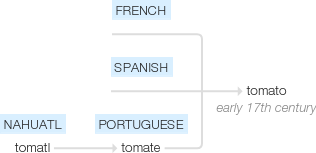Tomato
early 17th century: from French, Spanish, or Portuguese tomate, from Nahuatl tomatl .
wiktionary
Borrowed from Spanish tomate, from Classical Nahuatl tomatl, from Proto-Nahuan *tomatl.
etymonline
tomato (n.)
1753, earlier tomate (c. 1600), from Spanish tomate (mid-16c.) from Nahuatl (Aztecan) tomatl "a tomato," said to mean literally "the swelling fruit," from tomana "to swell." Spelling probably influenced by potato (1565). Slang meaning "an attractive girl" is recorded from 1929, on notion of juicy plumpness.
A member of the nightshade family, all of which contain poisonous alkaloids. Introduced in Europe from the New World, by 1550 they regularly were consumed in Italy but grown only as ornamental plants in England and not eaten there or in the U.S. at first. An encyclopedia of 1753 describes it as "a fruit eaten either stewed or raw by the Spaniards and Italians and by the Jew families of England." Introduced in U.S. 1789 as part of a program by then-Secretary of State Thomas Jefferson, but not commonly eaten until after c. 1830.
The older English name for it, and the usual one before mid-18c., was love-apple.
